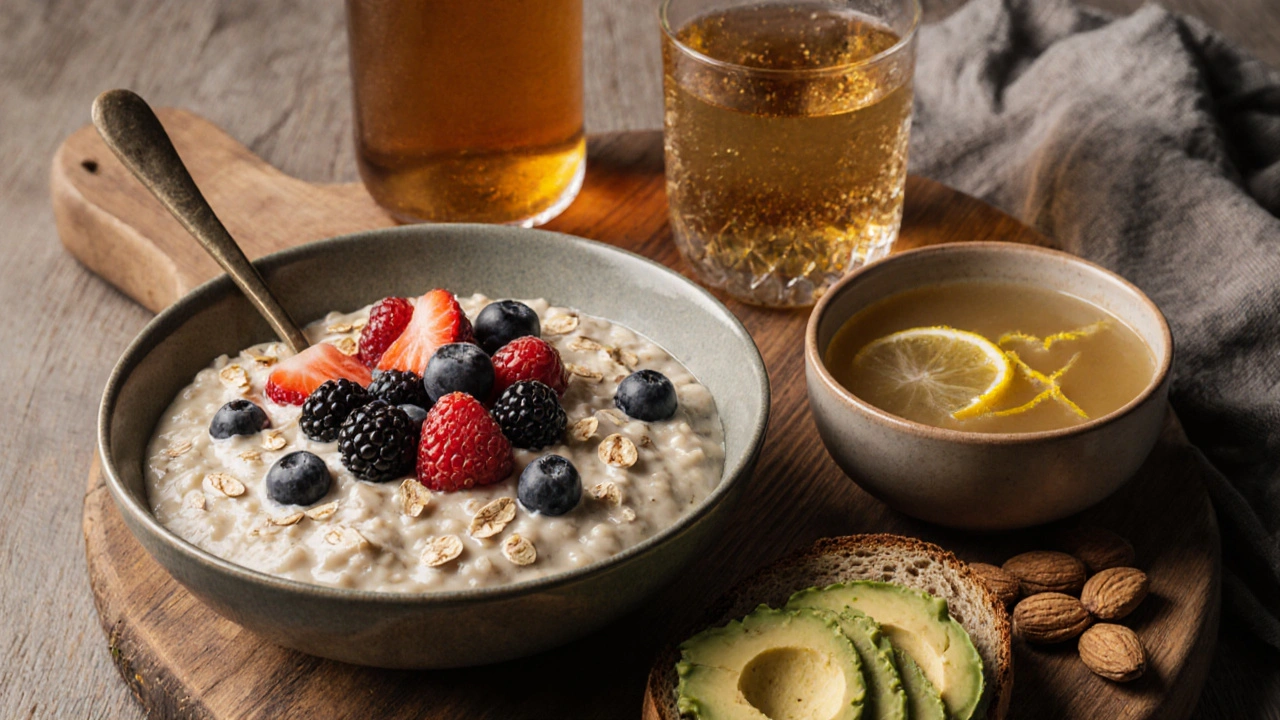Nutrition is a biological process that supplies the body with essential macro‑ and micronutrients, shaping immune function, gut integrity, and disease resistance. When the right balance of protein, vitamins, minerals, and bioactive compounds reaches the digestive tract, it can stop harmful microbes from taking hold and help the body bounce back after an infection. This article walks through the science behind those relationships, highlights the nutrients that matter most, and gives actionable eating plans for anyone looking to stay healthy or recover faster.
Enteric infections: a gut‑centric health threat
Enteric infections are illnesses caused by pathogenic bacteria, viruses, or parasites that invade the gastrointestinal (GI) tract. Common culprits include Escherichia coli, rotavirus, and Giardia lamblia. Symptoms range from mild stomach upset to severe watery diarrhea, dehydration, and, in vulnerable groups, life‑threatening electrolyte loss. The World Health Organization records over 1.7billion cases of diarrheal disease each year, with malnutrition accounting for roughly 45% of related deaths in children under five. Understanding how food influences these infections is therefore a public‑health priority.
Gut microbiota - the invisible partner
Every person harbors a dense community of bacteria, fungi, and viruses known as the gut microbiota. This ecosystem helps digest complex carbs, produces short‑chain fatty acids (SCFAs), and trains the immune system to distinguish friend from foe. Disruption, or dysbiosis, often precedes or follows an enteric infection. Research from the University of Sydney (2023) showed that children with higher bacterial diversity recovered from rotavirus‑induced diarrhea 30% faster than those with low diversity. Nutrition directly molds this community by providing substrates (prebiotics) and live beneficial strains (probiotics).
Probiotics and prebiotics - feeding the good guys
Probiotics are live microorganisms-typically Lactobacillus or Bifidobacterium species-that confer a health benefit when consumed in adequate amounts. Clinical trials in South Korea (2022) demonstrated that a daily dose of Lactobacillus rhamnosus GG reduced the duration of acute gastroenteritis by 1.5days. Prebiotics are non‑digestible fibers such as inulin, fructooligosaccharides, and resistant starch that selectively nourish these friendly microbes. A meta‑analysis of 18 studies (2021) linked prebiotic intake with a 25% lower risk of antibiotic‑associated diarrhea, underscoring the protective synergy between diet and microbiota.
Micronutrients that fight infection - a comparative look
Vitamins and minerals act as cofactors for enzymes, sustain barrier integrity, and modulate cytokine production. Below is a quick comparison of the three micronutrients with the strongest evidence for preventing or treating enteric infections.
| Micronutrient | Key Function | Effective Dose (per day) | Evidence Highlights |
|---|---|---|---|
| Zinc | Supports mucosal barrier, antiviral activity | 10mg (children), 20mg (adults) | Reduces diarrhea duration by ~50% (WHO 2020) |
| VitaminA | Maintains epithelial integrity, boosts IgA | 300µg RAE (children), 900µg RAE (adults) | Cuts severe diarrheal episodes by 30% (Bangladesh study 2021) |
| Iron | Essential for leukocyte proliferation | 12mg (children), 18mg (adults) | Improves recovery time when combined with zinc (Kenya trial 2022) |
All three nutrients are most effective when delivered through food sources-such as lean meat, dairy, legumes, leafy greens, and fortified cereals-rather than isolated supplements, because the food matrix aids absorption.
Macronutrients and immune resilience
Protein provides amino acids required for antibody synthesis, while carbohydrate fuels immune cells during infection. A diet containing at least 1.2g protein per kg body weight per day has been linked to faster mucosal healing after bacterial dysentery. Meanwhile, complex carbs from whole grains release glucose steadily, preventing the energy crashes that can blunt immune response. Fats, especially omega‑3 fatty acids from oily fish, generate anti‑inflamatory eicosanoids that reduce gut inflammation during infection.

Oral rehydration solution - the therapeutic bridge
Oral rehydration solution (ORS) is a precise mixture of sodium, potassium, glucose, and citrate that restores fluid balance while enhancing intestinal absorption of water. WHO recommends ORS as the first‑line treatment for any acute diarrheal episode. Combining ORS with zinc supplementation cuts mortality in children under five by 15% (global meta‑analysis 2020). The formulation can be homemade using clean water, a pinch of salt, and a spoonful of sugar, making it accessible in low‑resource settings.
Food safety and dietary diversity - the preventive backbone
Even the best‑designed nutrient plan fails if contaminated food enters the gut. Hand‑washing with soap, cooking meats to safe internal temperatures, and storing perishables at < 4°C dramatically lower infection risk. Meanwhile, a diverse diet-rich in fruits, vegetables, legumes, nuts, and fermented foods-provides a broad spectrum of phytochemicals, fibers, and microbes that collectively protect the gut lining.
Practical dietary strategies for prevention and recovery
- Daily baseline: Include a source of protein (e.g., beans, fish, eggs) at every meal, a serving of fruit or veg (especially orange‑fleshed sweet potatoes for vitaminA), and a handful of nuts or seeds for healthy fats.
- During illness: Sip ORS or a homemade solution (1L water + 6g glucose + 2.5g salt), add a probiotic yogurt, and prioritize easily digestible carbs like bananas and rice.
- Boost zinc: Snack on pumpkin seeds, chickpeas, or a zinc‑fortified cereal; consider a short‑term supplement if dietary intake is low.
- Prebiotic power: Cook onions, garlic, and leeks; include whole‑grain breads or oats; add a serving of cooked lentils.
- Hydration focus: Beyond water, include clear broths and coconut water for electrolytes.
These steps align with the “Nutrition‑First” model advocated by the Australian National Health and Medical Research Council (NHMRC, 2024), which places dietary quality at the core of infection control policies.
Linking to the wider knowledge cluster
This article sits within the broader field of nutritional immunology, which investigates how diet shapes systemic immunity. Narrower sub‑topics include “zinc supplementation protocols for pediatric diarrhea” and “fermented foods as adjunct therapy for enteric pathogens.” Readers interested in the bigger picture may explore related pieces on “Water, sanitation, and hygiene (WASH) interventions” or “The gut‑brain axis and post‑infectious irritable bowel syndrome.”
Frequently Asked Questions
Can I prevent travel‑related diarrhea with specific foods?
Yes. A high‑protein, low‑fat diet supplemented with zinc‑rich snacks (e.g., roasted pumpkin seeds) and a daily probiotic capsule can lower the incidence of traveler’s diarrhea by up to 35%. Staying hydrated with ORS and avoiding raw vegetables in high‑risk areas further cuts risk.
How much zinc is safe for a 2‑year‑old during a bout of diarrhea?
The WHO recommends 10mg of elemental zinc per day for children 6months to 5years, given for 10‑14days alongside ORS. Exceeding 20mg daily can cause nausea, so stick to the guideline.
Are fermented foods enough to replace probiotic supplements?
Fermented foods like kefir, kimchi, and sauerkraut provide live cultures, but strain diversity and dose can vary. For acute infection, a standardized probiotic supplement ensures an adequate colony‑forming unit (CFU) count; fermented foods work well for long‑term maintenance.
What role does vitaminA play during recovery?
VitaminA maintains the integrity of the intestinal epithelium and boosts secretory IgA, which traps pathogens in the gut lumen. A single high‑dose (200,000 IU) given within 24hours of onset can shorten recovery by 2‑3days in children.
Is homemade ORS as effective as commercial packets?
When prepared with precise measurements (1L clean water, 6g glucose, 2.5g salt), homemade ORS matches the osmolarity and rehydration efficiency of commercial solutions. The key is using clean water and accurate proportions.
How does dietary diversity reduce infection risk?
A varied diet supplies a wide range of phytochemicals, fibers, and micronutrients that together support gut barrier function and a balanced microbiota. Studies in rural Ghana showed that children consuming five or more food groups daily had a 40% lower odds of diarrheal disease.

Christian Freeman
When we look at nutrition through a philosophical lens, we see the gut as a microcosm of balance: what we feed it shapes the very dialogue between host and microbes. In this sense, every bite is a subtle negotiation that can tip the scales toward health or disease.
julie shayla
Oh great, another endless list of "superfoods" that promise to banish diarrhea like magic. As if sprinkling zinc on a banana will instantly turn the gut into a fortress. The reality is far messier, and most of these claims ignore socioeconomic realities.
Super Mom
From a practical standpoint, start your day with a protein‑rich breakfast-think eggs or Greek yogurt-paired with a slice of whole‑grain toast. Add a handful of pumpkin seeds for a zinc boost, and you’ll give your immune system the building blocks it needs to fight off enteric pathogens.
Spencer Riner
It’s fascinating how prebiotic fibers act like fuel for friendly bacteria, essentially training the gut to outcompete invaders. That cooperative relationship underscores why dietary diversity isn’t just a buzzword but a strategic defense mechanism.
Joe Murrey
i cant beleive how simple home ORS is.
Tracy Harris
One must acknowledge that the interplay between micronutrients and enteric pathogen resistance is grounded in a substantial body of epidemiological evidence. Zinc, for instance, has been repeatedly demonstrated to reduce the duration of diarrheal episodes by approximately fifty percent, a statistic corroborated by the World Health Organization in 2020. Vitamin A, through its role in maintaining epithelial integrity and augmenting secretory IgA, contributes to a measurable decline in severe diarrheal manifestations, as evidenced by the Bangladesh cohort study of 2021. Iron, while essential for leukocyte proliferation, must be judiciously administered to avoid fostering pathogenic overgrowth within the lumen. The synergistic administration of zinc and iron has been shown, in a Kenyan trial conducted in 2022, to accelerate convalescence when both are provided in appropriate dietary matrices. Moreover, the ingestion of probiotic strains such as Lactobacillus rhamnosus GG furnishes a competitive advantage to the resident microbiota, limiting colonisation by virulent organisms. Prebiotic substrates, including inulin and resistant starch, selectively enhance the proliferation of these beneficial microbes, thereby reinforcing mucosal barrier function. It is imperative to source these nutrients primarily from whole foods-lean meats, legumes, leafy greens, and fortified cereals-since the food matrix facilitates optimal bioavailability. Adequate protein intake, approximating 1.2 g per kilogram of body weight, supports the synthesis of immunoglobulins necessary for pathogen neutralisation. Complex carbohydrates from whole grains mitigate rapid glucose spikes, ensuring a steadier supply of energy for immune cell activity. Omega‑3 fatty acids, abundant in oily fish, contribute anti‑inflammatory eicosanoids that attenuate gut inflammation during infection. Oral rehydration solutions remain the cornerstone of acute diarrhoea management; their osmolarity, calibrated with precise concentrations of sodium, potassium, and glucose, maximises fluid absorption. The concomitant administration of zinc with ORS has been demonstrated to reduce mortality in children under five by fifteen percent on a global scale. Finally, rigorous food safety practices-hand‑washing, thorough cooking, and appropriate refrigeration-constitute the indispensable preventive foundation upon which all nutritional strategies must be built.
Sorcha Knight
Honestly, sweetie, your sarcasm is as thin as a rice cracker, but the truth remains: you can’t just shrug off the science. 🍽️ Proper nutrition isn’t a gimmick, it’s a lifeline, especially for the vulnerable.
Jackie Felipe
i think we should all eat more fruit and veg its good for gut health but many people dont know how to cook them right
debashis chakravarty
While the cited studies are compelling, it is essential to scrutinise the methodological heterogeneity across trials, particularly concerning dosage standardisation of zinc and the probiotic strains employed. Without such rigour, the purported universal applicability remains speculative.
Daniel Brake
One could observe that integrating fermented foods into daily meals may subtly modulate the microbiota, potentially offering a gentle adjunct to conventional therapy during mild diarrhoeal episodes.
Avinash Sinha
Picture this: a swirling vortex of fermented kimchi, bold kefir, and crunchy sauerkraut marching into the gut like an army of microscopic heroes, slaying rogue pathogens with flamboyant flair.
ADAMA ZAMPOU
In conclusion, a comprehensive nutritional strategy-encompassing adequate macro‑and micronutrient intake, judicious use of probiotics and prebiotics, and adherence to stringent food safety protocols-constitutes an evidence‑based paradigm for the prevention and amelioration of enteric infections.